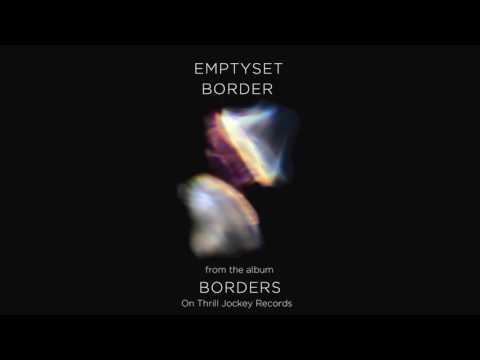“There’s been a lot left on the cutting room floor in the last two years. Not just in terms of music, but in terms of feeling out entirely different ways the project could go,” explains James Ginzburg via an unreliable Skype connection (my bad). “Maybe the nicest thing about this record is that we left piles and heaps of detritus on the cutting room floor, but now we both have a much clearer sense of the kind of future for the project.”
In a recent review of the latest Emptyset album (out later this month via Thrill Jockey), yours truly described Borders as “their Fury Road”. The album arrives three years after Recur brought to a close a trilogy exploring structural compositions of shuddering booms and bass vibrations repeatedly likened to architectural works. Borders however re-examines and reboots the duo’s sound, taking an entirely different approach, swapping out their clean digital source material for a pair of rugged and simplistic self-built instruments. Early in my conversation with Paul Purgas and James Ginzburg, they bring up the Mad Max comparison and seem to find it as insightful as they do laughable. “In our heads we did always think about this trilogy structure,” says Purgas. “But at the same time, I knew what we said in an interview three or four years ago about it would come back to haunt us. Also we don’t have that dude on the guitar with the flamethrower.”
Following Recur the duo took the process of digital sound-sculpting and site-specific recording they’d been refining, and completed their most ambitious project yet in the form of Signal. Developed over the best part of the year, Signal culminated in a performance in Berlin on 1st February 2015, wherein the duo bounced high frequency radio signals off the ionosphere between receiving stations in Germany and France, ultimately imprinting the audio performed in Berlin with nuances picked up in the atmosphere. “We thought we’d tour that”, explains Ginzburg, ”and that would buy us some time to think about what we were doing in terms of another LP. We soon realised that it requires so many resources to make it happen, multiple transmitters and receiving stations over multiple countries, that there was just no way we’d ever do it again as a performance. Eventually we were sitting in Amsterdam in Schiphol airport in a pretty gloomy kind of mood thinking, are we going to continue doing this?” Purgas agrees: “with Signal, it had almost become so abstracted from the act of ‘music making’ or production in any normal sense – it felt like we just needed to revert back to as basic and direct a way of music making as possible.”
Once you’ve turned entire buildings into instruments as on Medium, and then you’ve made the ionosphere itself an instrument as on Signal, where do you go next? Unless you start talking to NASA, the only option is to pause, and head back in the other direction.
Having worked with incredibly hands-off chains of gear shaping and distorting digital signals from minimal helpings of beats and bass into shuddering noise techno juggernauts, Purgas and Ginzburg pretty quickly concluded the process had to become more physically involving. “We started thinking about music from its sort of anthropological starting point and those various early ways of making percussive music,” says Ginzburg. “We looked to distill what we were doing to be as elemental as possible, and as capable of representing the same kind of structural elements that we were using in our previous work. We didn’t want to make a record and then work out how to make it into a performance, we wanted to make a system that was a performance system.”
For anybody who’s witnessed an Emptyset live show, there’s a palpable sense of ceremony in the jagged patterns of tones and thuds they produce which – besides the sheer amperage necessary to prop up said wads of bass – already had more than a little in common with the simplest musical forms. “We were looking at certain non-Western musical settings and thinking about that structure of, quite literally, drums and strings,” says Purgas. “Within an Indian context that’d be like the tabla and the sitar, or you can go back far further in an anthropological sense. It was useful for us to think about that very reduced way of making music.”
So the duo set about building the simplest possible drum and a zither-like single string instrument to replace those weightless digital bleeps in their equipment chain with something earthen and organic. “It’s the difference between it just being ‘designed’, and requiring us to act with spontaneity,” says Ginzburg. “This was a move towards allowing anything structural to be produced in a way that was gestural with physical movement.”
With this switch to analogue, Emptyset’s deep roots in more rigidly rhythmic Bristolian strands of bass music seem to have all but disappeared from the rear-view mirror. Nonetheless, the pair’s new rugged analogue core still relies on similar processes to turn base metals into brutalist monoliths. Stress-testing compositions and systems more like structural engineers than musicians has been a key part of the project all along, as discussed in their 2012 chat with Rory Gibb for tQ. The ways in which a slug of entropy thrown into tightly regulated system can be exploited are perhaps more than anything responsible for the duo’s dramatic resonance, sculpting physical vibrations with godlike force. It’s even there in the album names – Demiurge referring to the craftsman of the physical world in Platonic philosophy. Borders certainly hints at them toying with the edges of the universe they’ve created. “A system sort of naturally dictates the boundaries and the structures,” says Ginzburg about their new setup including the self-built instruments. “There’s always certain ways of acting and things you can do to yield interesting results, then as you discover these properties in the system you focus in on them, and try to bring as much out of them as possible. One part of it is you activating this process through performance, then there’s this other secondary aspect of the system feeding back immediately to you. The system drives you as much as you drive the system.”
“This time, there was just a sense of play,” explains Purgas. “Spending some time just simply performing and improvising, the structures just seemed to emerge out of that process – and quickly as well! It’s surprising how some of the tracks on the album almost emerged from the very first times we started performing.” Ginzburg cuts in, “it’s interesting to think had we made other design decisions, how that would have determined the results.”
While they’ve jettisoned site-specific experiments and a digital signal chain in favour of primordial instruments and analogue processing, the duo have retained the defining tool in their arsenal: distortion. “I’m more interested in distortion as a way of creating complex harmonic sounds than synthesis,” says Ginzburg. “Distortion represents something that is in quite complicated relationship to the source sound, and depending on the circuit it has a life of its own and a complexity you couldn’t contrive. It’s a perfect tool for us. I guess there’s a poetic analogy between these relationships between order and chaos… and orderly chaos.”
In the past Emptyset have even joked that their digital signal chain sans all the processing would be outright comical to listen to. “I guess [distortion] gives voice to a certain type of technology, and allows it to speak through and map itself onto sounds. We kind of approached the whole project with that approach, almost with this alchemical quality, having a very clear map of what goes into a system, but somehow distortion is able to give voice to and animate it into something that you can’t predetermine or map out. “
During our conversation I point out how certain tracks on Borders instantly brought to my mind the momentous chug and riffs of metal. More than just the sheer heaviosity, the speed and might with which Purgas and Ginzburg epically twang that distorted string and a pummeling that drum work mightily well for headbanging. “It was definitely a thing we flagged up in the production process, that once you use those certain tools with certain equipment, obviously you’re treading closer to that territory,” explains Purgas. “So we tried to find the points where we could actually dial it back. One of the things we noticed working later in the production process was actually stepping away from the outboard in certain places, and allowing the instruments themselves to have more voice.”
Indeed on tracks like ‘Speak’ the dry sound of the unamplified zither string has also been captured in the studio and added to the final mix, inserting the duo more literally and physically into the music than before. ”That was actually a really last minute decision, right when we were just about to hit record,” explains Ginzburg. “It ended up helping make the thing feel sonically complete, and took it away from everything just being confined within this electronic signal path. As we were working on it, we just wanted to hear more and more of the organic texture and less and less of the electronic texture, so I think ‘Speak’ was one of the last tracks we did. I think there’ll be less and less emphasis on the electronic aspect of things in the future.” Purgas agrees: “things that were much more fortuitous that went into realising the final aesthetic – those happy accidents that go into the production process.”



